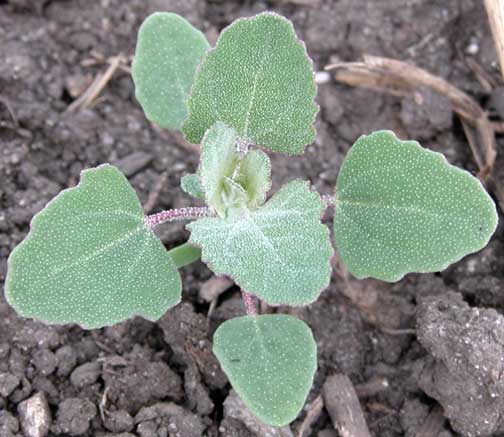Large common lambsquarters is a problem for glyphosate
|
Recent lack of rain, and windy conditions that hampered herbicide applications, have resulted in weedy fields that are effectively reducing yields in corn and soybean. A particular concern is fields with heavy populations of common lambsquarters that have not been controlled effectively by glyphosate. In discussions with growers and applicators, the failure of glyphosate, even when applied at 48 oz per acre (1.1 lb ae/acre) to provide control, does not appear to be attributable to evolved resistance to glyphosate, but rather a combination of factors: common lambsquarters that is too large and has developed during dry conditions, and applications that were too late to provide consistent control and protection of potential crop yields. Please recognize that evolved resistance of common lambsquarters cannot be ruled out based only on discussions, but this seems highly unlikely given the circumstances described. The options available to resolve this problem are not good. Another application of glyphosate may help, particularly if dry conditions have abated. Also, there are several herbicides that have activity on common lambsquarters and specifically have supplemental labels for application in combination with glyphosate. Harmony® GT can be applied to soybean after the first trifoliolate has fully expanded until 60 days before harvest. However, the size of common lambsquarters described on the label is a maximum of 4". Furthermore, there is a cautionary statement that describes an elevated risk of soybean injury during hot and humid conditions. Ultra Blazer® can be applied on soybeans up to 50 days prior to harvest; however, applications later in the growing season on soybeans approaching flowering are more likely to result in injury that can reduce potential yields. Also, common lambsquarters control requires a 1.5 pt/acre rate and the weeds should be no taller than 2". Phoenix® herbicide has a 45-day preharvest application interval and describes "enhanced control of common lambsquarters in soybeans" using a combination of Phoenix® plus FirstRate® plus Harmony® GT. Applications are restricted to soybeans with 2 to 4 trifoliolates. Raptor® herbicide describes control of common lambsquarters when the weeds are 2 to 5" and applications are made prior to soybean bloom stage. Furthermore, a supplemental label describes Raptor® plus Roundup Ultra®. There are likely other herbicide options available. It is difficult to predict whether the alternate herbicide applications described will provide better control of large common lambsquarters than a second application of glyphosate. Also, the potential for soybean injury is greater with the alternate herbicides and the severity of the injury increases as soybeans approach reproductive development. As always, hindsight is 20:20. In the future, it is recommended that an early preplant or preemergence application, including herbicides that provide control of common lambsquarters, be used in the weed management plan. Follow the soil-applied herbicides with timely postemergence applications when the target weeds are small. Make sure that if glyphosate is the product of choice, you do not use lower rates when the intended target weeds are those that have been historically difficult to control with glyphosate. This article originally appeared on page 182 of the IC-496(16) -- June 19, 2006 issue. Updated 11/09/2006 - 10:56am
|




